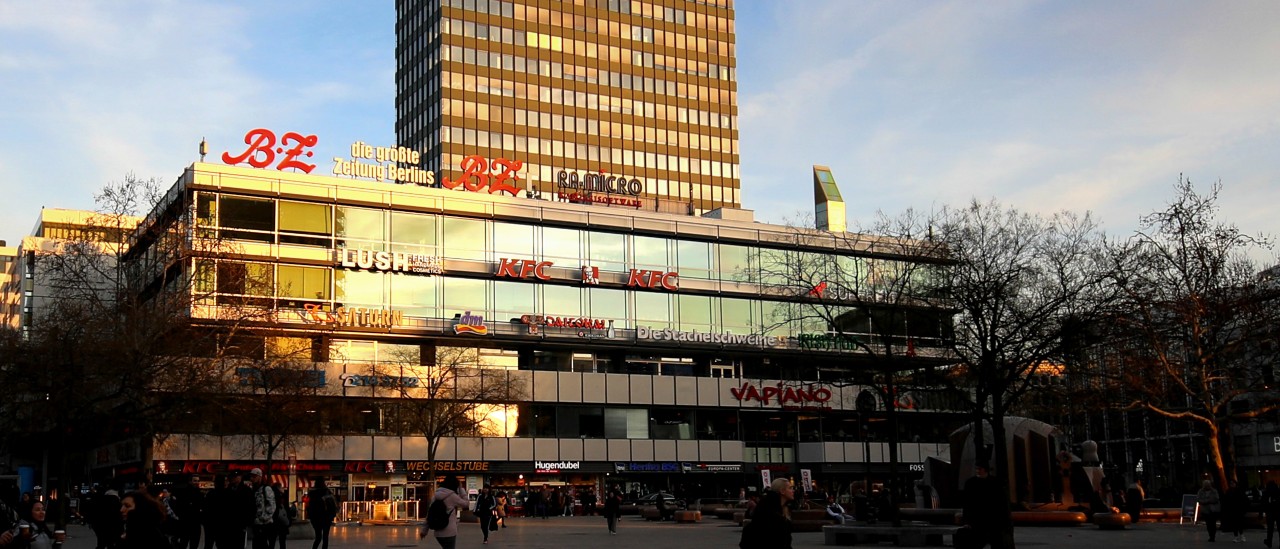
Places of interest
Zoological Garden
The Zoological Garden was founded in 1841 and opened in 1844. This makes it the oldest zoo in Germany and, together with the aquarium, the most species-rich zoo in the world. A total of almost 20,000 animals currently live in Berlin Zoo. Among them are elephants, giraffes, gorillas and, unique in Germany, giant pandas.
There are two entrances to the Zoological Garden. One entrance is at Hardenbergplatz and leads through the Löwentor, the other in Budapester Straße, right next to the imposing Elephant Gate is also the Aquarium.
For information on opening hours and guided tours, please visit the website of the Zoological Garden and the aquarium.
Kaiser Wilhelm Memorial Church
The Kaiser Wilhelm Memorial Church was designed by Franz Heinrich Schwechten, built in 1891-95 and finally consecrated on 1 September 1895. Large parts of the neo-Romanesque building were unfortunately destroyed during the Second World War, in a bombing raid in November 1943, and for a long time it was unclear what was to be done with the ruins. Finally, a competition was announced.
The winner of the competition was the architect Egon Eiermann. His design envisaged the demolition of the church and a modern new building. However, these plans did not find support among the population and therefore triggered a passionate architectural debate. A compromise was reached: the 68-metre high main tower of the church was retained as a memorial and the new Kaiser Wilhelm Memorial Church was built next to the old one.
For information on opening hours and guided tours, please visit the website of the Kaiser Wilhelm Memorial Church.
Breitscheidplatz
Breitscheidplatz, named after the SPD politician Rudolf Breitscheid, was given its present form in 1984. It is located between Kurfürstendamm, Tauentzienstraße and Budapester Straße and essentially occupies the area of the former Auguste Viktoria Platz, which was one of the most important junctions of the New West in the 1920s. In the centre of the square is the main tower of the Kaiser Wilhelm Memorial Church, which was largely destroyed in the Second World War, flanked by the glass towers of the new Memorial Church designed by architect Egon Eiermann.
The clock of flowing time
The water clock in the Europa Center in Berlin, also known as "The Clock of Flowing Time", is an impressive work of art designed by the Frenchman Bernard Gitton and realised in 1982. Here is a detailed description of how it works:Structure
- Height: The clock is 13 metres high and extends over a total of 3 floors.
- Bullets: It consists of 12 large and 30 flattened, small glass balls.
- Liquid: The clock uses a neon green liquid that is controlled by a violet pendulum.
- minutes: The small balls indicate the minutes. Each of the small balls fills in 2 minutes, so that the 30 balls in total correspond to a full hour.
- Hours: The hours that have already passed can be seen from the number of large balls that have already been filled.
- Example: For example, if 10 large and 15 small balls are filled, it is 10:30 or 22:30, depending on whether the count is before or after noon.
- Change of hours: Once 60 minutes have elapsed, i.e. 30 of the small, flat glass spheres have been filled, their contents drain into the relevant large sphere to indicate the full hour, and the cycle of the small spheres begins again.
- Day change: Consequently, at 1:00 a.m. and 1:00 p.m., the entire system empties except for the hour display of 1:00 a.m. and 1:00 p.m. respectively, and the cycle of the entire system and the large balls begins again.
- Pendulum: The movement of the neon green liquid inside the clock is controlled by a violet pendulum, which is driven by the water drainage in the upper shell.
Source
The Set Theory Clock
The Berlin clock, also known as the Mengenlehreuhr, is a public clock in Berlin that was developed by Dieter Binninger in 1975. It shows the time via a number of illuminated lamps. Here is an explanation of how the clock works:
- Display principleDespite the name "set theory clock", the clock has nothing to do with set theory. Time is represented in a place value system on base 5.
- Hours and minutes: The hours and minutes are represented by luminous segments in four horizontal strips arranged one below the other. There are four luminaires in the first, second and fourth rows, and eleven luminaires in the third.
- Hour displayThe first two lines indicate the hour with red lights. In the upper strip, a lit segment stands for five hours, and in the lower strip for one hour. The current hour results from the addition of the values.
- Minute display: In the two lower lines, the minutes are displayed with yellow segments in steps of five and one. The lights for 15, 30 and 45 minutes are red for better readability.
- Seconds display: Above the lines there is a round flashing light that is switched on or off every second.
The clock was originally erected on the corner of Kurfürstendamm and Uhlandstraße and later re-installed in front of the Tourist Information Centre in Berlin's Europa Center on Budapester Straße.
The Berlin clock was unusual in its time and small replicas were even made for home use. The clock was also sold as a table stand and wall model and remains an interesting piece of Berlin history.
Source: Wikipedia




